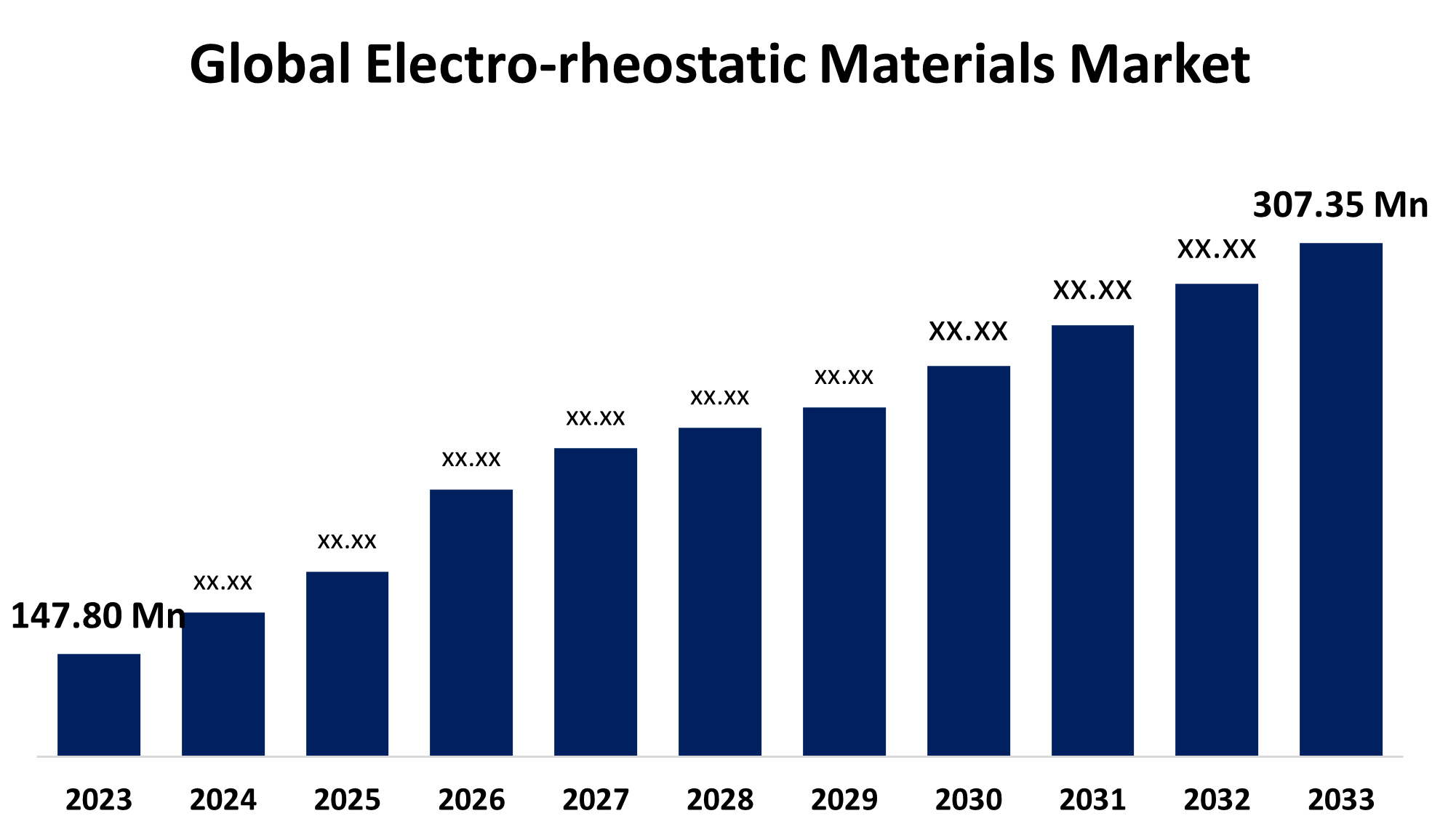Global Electro-rheostatic Materials Market Size, Share, and COVID-19 Impact Analysis, By Material Type (Conductive Polymers, Metal Alloys, Carbon Nanotubes, Liquid Crystals, Graphene-based Materials, and Others), By Application (Electronics, Automotive, Aerospace, Healthcare, Robotics, Consumer Goods, and Others), and By Region (North America, Europe, Asia-Pacific, Latin America, Middle East, and Africa), Analysis and Forecast 2023 - 2033.
Industry: Chemicals & MaterialsGlobal Electro-rheostatic Materials Market Insights Forecasts to 2033
- The Global Electro-rheostatic Materials Market Size was estimated at USD 147.80 Million in 2023
- The Market Size is Expected to Grow at a CAGR of around 7.60% from 2023 to 2033
- The Worldwide Electro-rheostatic Materials Market Size is Expected to Reach USD 307.35 Million by 2033
- Europe is expected to grow the fastest during the forecast period.

Get more details on this report -
The Global Electro-rheostatic Materials Market Size is expected to cross USD 307.35 Million by 2033, growing at a CAGR of 7.60% from 2023 to 2033. The advancement in smart technologies and expansion into medical devices are significantly contributing to driving the electro-rheostatic materials market growth.
Market Overview
The market for materials with electro-rheological (ER) properties that is, materials whose viscosity or flow behavior can be regulated or changed by applying an electric field is known as the electro-rheostatic materials market. These materials are commonly utilized in a variety of applications, including sensors, brakes, dampers, and actuators. The electro-rheostatic materials market is centered on the creation and usage of materials that react to an electric field by changing their viscosity. These materials are useful in sectors that need exact control over fluid behavior, motion, or damping. Electro-rheostatic materials market is becoming more and more necessary due to the ongoing advancement of smart technologies and the desire for more interactive and flexible systems, which drives market growth and innovation. In addition, more businesses use automation technologies to streamline their processes, there is a growing demand for sophisticated materials that provide accurate and responsive control, which is driving the electro-rheostatic materials market.
Report Coverage
This research report categorizes the electro-rheostatic materials market based on various segments and regions forecasts revenue growth and analyzes trends in each submarket. The report analyses the key growth drivers, opportunities, and challenges influencing the electro-rheostatic materials market. Recent market developments and competitive strategies such as expansion, type launch, development, partnership, merger, and acquisition have been included to draw the competitive landscape in the market. The report strategically identifies and profiles the key market players and analyses their core competencies in each sub-segment of the electro-rheostatic materials market.
Global Electro-rheostatic Materials Market Report Coverage
| Report Coverage | Details |
|---|---|
| Base Year: | 2023 |
| Market Size in 2023: | USD 147.80 Million |
| Forecast Period: | 2023-2033 |
| Forecast Period CAGR 2023-2033 : | 7.60% |
| 2033 Value Projection: | USD 307.35 Million |
| Historical Data for: | 2019-2022 |
| No. of Pages: | 210 |
| Tables, Charts & Figures: | 110 |
| Segments covered: | By Material Type, By Application, By Region |
| Companies covered:: | Covestro AG, DuPont, Evonik Industries AG, 3M, BASF SE, SABIC, Henkel AG & Co. KGaA, Avient Corporation, RTP Company, Evonik Industries AG, Huntsman International LLC., and other key vendors |
| Pitfalls & Challenges: | COVID-19 Empact,Challenges, Future, Growth, & Analysis |
Get more details on this report -
Driving Factors
Increased spending on scientific research and development, the expanding number of deliveries by aircraft, and the growing absorption of the healthcare industry are all driving the electro-rheostatic materials market. Healthcare expenditures are driving the electro-rheostatic materials market. These tools for controlling the flow of electricity are practical and affordable. The market for electro-rheostatic materials is being driven by the growing need for smart materials in end-use industries. Growing expenditures on surgical equipment by the pharmaceutical industry are driving the electro-rheostatic materials market.
Restraining Factors
Costly manufacturing procedures and growing R&D investment costs are impeding the industry's growth. Higher production costs can result from the development of electro-rheostatic materials that require the use of sophisticated equipment and processes in the market.
Market Segmentation
The electro-rheostatic materials market share is classified into material type and application.
- The conductive polymers segment held the largest share in 2023 and is expected to grow at a significant CAGR during the forecast period.
Based on the material type, the electro-rheostatic materials market is divided into conductive polymers, metal alloys, carbon nanotubes, liquid crystals, graphene-based materials, and others. Among these, the conductive polymers segment held the largest share in 2023 and is expected to grow at a significant CAGR during the forecast period. Numerous industries, including robotics, consumer electronics, and the automotive sector, can readily include conductive polymers. They are frequently found in goods that call for materials that are sensitive and flexible.
- The electronics segment held the largest share in 2023 and is expected to grow at a significant CAGR during the forecast period.
Based on the application, the electro-rheostatic materials market is divided into electronics, automotive, aerospace, healthcare, robotics, consumer goods, and others. Among these, the electronics segment held the largest share in 2023 and is expected to grow at a significant CAGR during the forecast period. Electro-rheostatic materials can improve wearables and smart devices’ performance by offering dynamic control capabilities. There is continuous growth in the miniaturization of electronic products necessitating the use of packaging materials that provide enhanced performance.
Regional Segment Analysis of the Electro-rheostatic Materials Market
- North America (U.S., Canada, Mexico)
- Europe (Germany, France, U.K., Italy, Spain, Rest of Europe)
- Asia-Pacific (China, Japan, India, Rest of APAC)
- South America (Brazil and the Rest of South America)
- The Middle East and Africa (UAE, South Africa, Rest of MEA)
Asia Pacific is anticipated to hold the largest share of the electro-rheostatic materials market over the predicted timeframe.

Get more details on this report -
Asia Pacific is anticipated to hold the largest share of the electro-rheostatic materials market over the predicted timeframe. The electro-rheostatic materials market in the Asia-Pacific region due to its robust industrial base, quick technological development, and high demand for consumer electronics and automotive applications. The region's leadership in the global market for electro-rheostatic materials is fueled by its focus on innovation and production capabilities. The market is growing due in large part to the substantial expenditures made in manufacturing and technology by nations like as China, Japan, and South Korea.
Europe is expected to grow at the fastest CAGR growth of the electro-rheostatic materials market during the forecast period. The rapidly expanding automotive and home electronics sectors in Europe, along with the extensive use of Internet of Things (IoT) technologies, are the main causes. The growing automobile, electronics, and power industries gave Europe a significant market share. Another factor driving the industry's expansion is the substantial investment made by big businesses in sophisticated motors and actuators.
Competitive Analysis:
The report offers the appropriate analysis of the key organizations/companies involved within the electro-rheostatic materials market along with a comparative evaluation primarily based on their type of offering, business overviews, geographic presence, enterprise strategies, segment market share, and SWOT analysis. The report also provides an elaborative analysis focusing on the current news and developments of the companies, which includes type development, innovations, joint ventures, partnerships, mergers & acquisitions, strategic alliances, and others. This allows for the evaluation of the overall competition within the market.
List of Key Companies
- Covestro AG
- DuPont
- Evonik Industries AG
- 3M
- BASF SE
- SABIC
- Henkel AG & Co. KGaA
- Avient Corporation
- RTP Company
- Evonik Industries AG
- Huntsman International LLC.
- Others
Key Target Audience
- Market Players
- Investors
- End-users
- Government Authorities
- Consulting And Research Firm
- Venture capitalists
- Value-Added Resellers (VARs)
Market Segment
This study forecasts revenue at global, regional, and country levels from 2023 to 2033. Spherical Insights has segmented the electro-rheostatic materials market based on the below-mentioned segments:
Global Electro-rheostatic Materials Market, By Material Type
- Conductive Polymers
- Metal Alloys
- Carbon Nanotubes
- Liquid Crystals
- Graphene-based Materials
- Others
Global Electro-rheostatic Materials Market, By Application
- Electronics
- Automotive
- Aerospace
- Healthcare
- Robotics
- Consumer Goods
- Others
Global Electro-rheostatic Materials Market, By Regional Analysis
- North America
- US
- Canada
- Mexico
- Europe
- Germany
- UK
- France
- Italy
- Spain
- Russia
- Rest of Europe
- Asia Pacific
- China
- Japan
- India
- South Korea
- Australia
- Rest of Asia Pacific
- South America
- Brazil
- Argentina
- Rest of South America
- Middle East & Africa
- UAE
- Saudi Arabia
- Qatar
- South Africa
- Rest of the Middle East & Africa
Frequently Asked Questions (FAQ)
-
What is the CAGR of the electro-rheostatic materials market over the forecast period?The electro-rheostatic materials market is projected to expand at a CAGR of 7.60% during the forecast period.
-
What is the market size of the electro-rheostatic materials market?The Global Electro-rheostatic Materials Market Size is Expected to Grow from USD 147.80 Million in 2023 to USD 307.35 Million by 2033, at a CAGR of 7.60% during the forecast period 2023-2033.
-
Which region holds the largest share of the electro-rheostatic materials market?Asia Pacific is anticipated to hold the largest share of the electro-rheostatic materials market over the predicted timeframe.
Need help to buy this report?